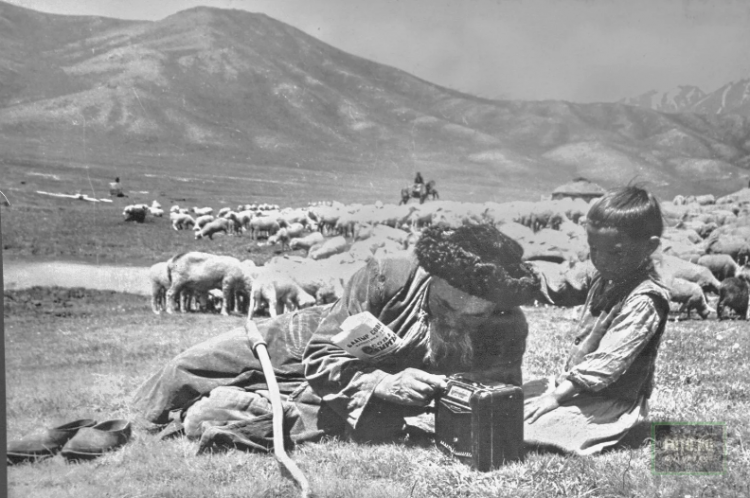
The party, Soviet, land authorities, and leaders of collective and state farms did everything possible to organize the harvest of 1942 in a timely manner and without losses. During the harvest season, 980 combines worked in the fields. The production leaders demonstrated exemplary selfless labor. The first to fulfill the harvesting plan in Kyrgyzstan by July 20, 1942, was combine operator Yaushev from the Kholmion MTS of the Osh region. He harvested 300 hectares and saved a significant amount of fuel. Combine operator Ruzhimov from the Bazar-Kurgan MTS of the Jalal-Abad region harvested 10-15 hectares daily in the collective farm "Kyzyl-Ai," instead of the 8 hectares stipulated by the norm, and by July 25, his output amounted to 226 hectares. Tractor driver Abdrahmanov from the same MTS worked hard during the harvest days. With a set of four header attachments, he mowed 12-16 hectares a day. To prevent losses of cut ears, grain catchers were installed on the machine platforms.
It should be emphasized, however, that in 1942, combines harvested only 167.2 thousand hectares of grain, or 21.3%. More than 78% of the grain had to be harvested using horse-drawn machines and by hand. A particularly notable contribution was made by collective farm member Surbek Teshagulov from the Frunze collective farm in the Leninpol district of the Talas Valley: he mowed 0.75 hectares of wheat a day with a sickle, against a norm of 0.15 hectares, achieving 500% of the target, and when he switched from a sickle to a hand scythe, he harvested over 2 hectares a day — 250% of the target. His annual output amounted to 572 labor days.
Every day, Jetigen Sopieyev from the agricultural artel "Sary-Sogot" in the Toktogul district of the Jalal-Abad region manually mowed 1.25 hectares against a norm of 0.25 hectares. Over 22 working days, he harvested 25.5 hectares, setting a world record.
A decisive struggle was waged against crop losses. To gather the ears of grain, 60.4 thousand students from rural schools and some city residents were mobilized. They collected ears from 245 thousand hectares — 36% of the total harvested area. "Every pood of grain collected is a combat contribution of collective farmers to the defeat of the enemy" — under this slogan, the battle for every grain was fought. As a result, in 1942, an additional 167.3 thousand poods of grain were collected from the collective farms of the republic.
The successful conduct of the most important agricultural campaigns was significantly aided by front-line ten-day and monthly work periods.
The first similar event in the collective farms and state farms of the republic, following the completion of the grain harvest and bread supplies to the state, took place from September 3 to 13, 1942. "Work on the Frontline" was the slogan of the workers. More than 300 collective farms in the Osh region successfully completed the grain harvest. The initiative of the collective farmers inspired the residents of the cities; on one Sunday, about 5 thousand residents of Osh went out to the fields and harvested over 2 thousand hectares of grain.
In total, in the collective farms of Kyrgyzstan in 1942, 743.3 thousand hectares (743,363) of grain were actually harvested, while 27.5 thousand hectares remained unharvested under the snow. The yield was 9.6 centners per hectare compared to 10.6 centners per hectare in 1940, with a gross harvest of 747.6 thousand tons of bread, which was significantly more than in 1940.
According to the results of the All-Union Socialist Competition in 1942, the Kirghiz SSR was awarded the third prize — the banner of the USSR People's Commissariat of Agriculture and the All-Union Central Council of Trade Unions for outstanding work in crop production and grain procurement. A telegram was sent to the Central Committee of the Party and the Council of People's Commissars of the Kirghiz SSR from the President of the Academy of Sciences of the USSR, Academician V. L. Komarov. It stated: "I warmly congratulate you on behalf of the workers of the Kirghiz SSR — the winners of the socialist competition in agriculture for 1942, and I express confidence that the decision of the USSR Council of People's Commissars to award the Kirghiz Republic the third prize for high yields will serve as a powerful stimulus for a new rise in the socialist agriculture of Kyrgyzstan. I wish the workers of Kyrgyzstan further success in the current year."
Changes in the Structure of Sown Areas in Kyrgyzstan in 1942











































